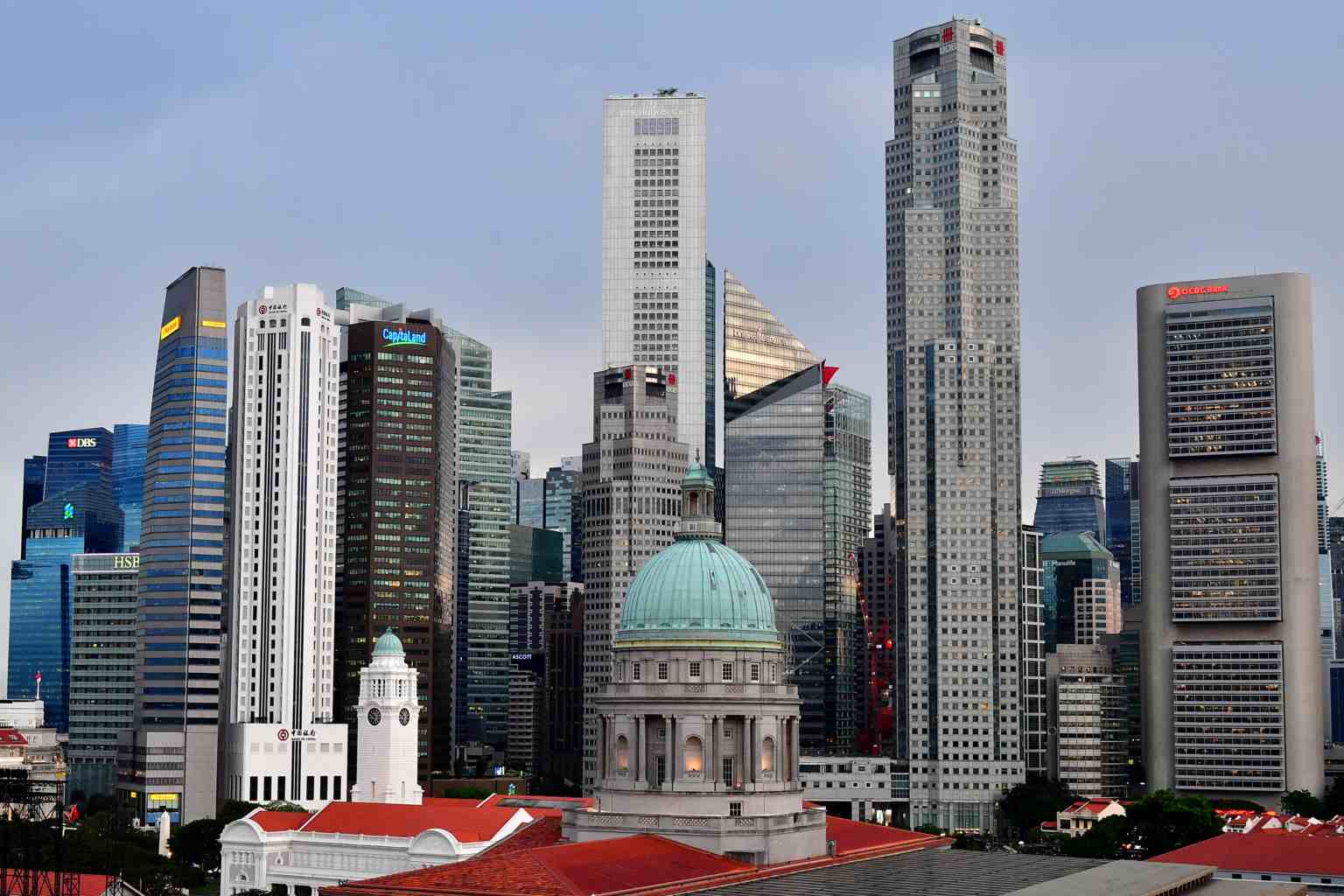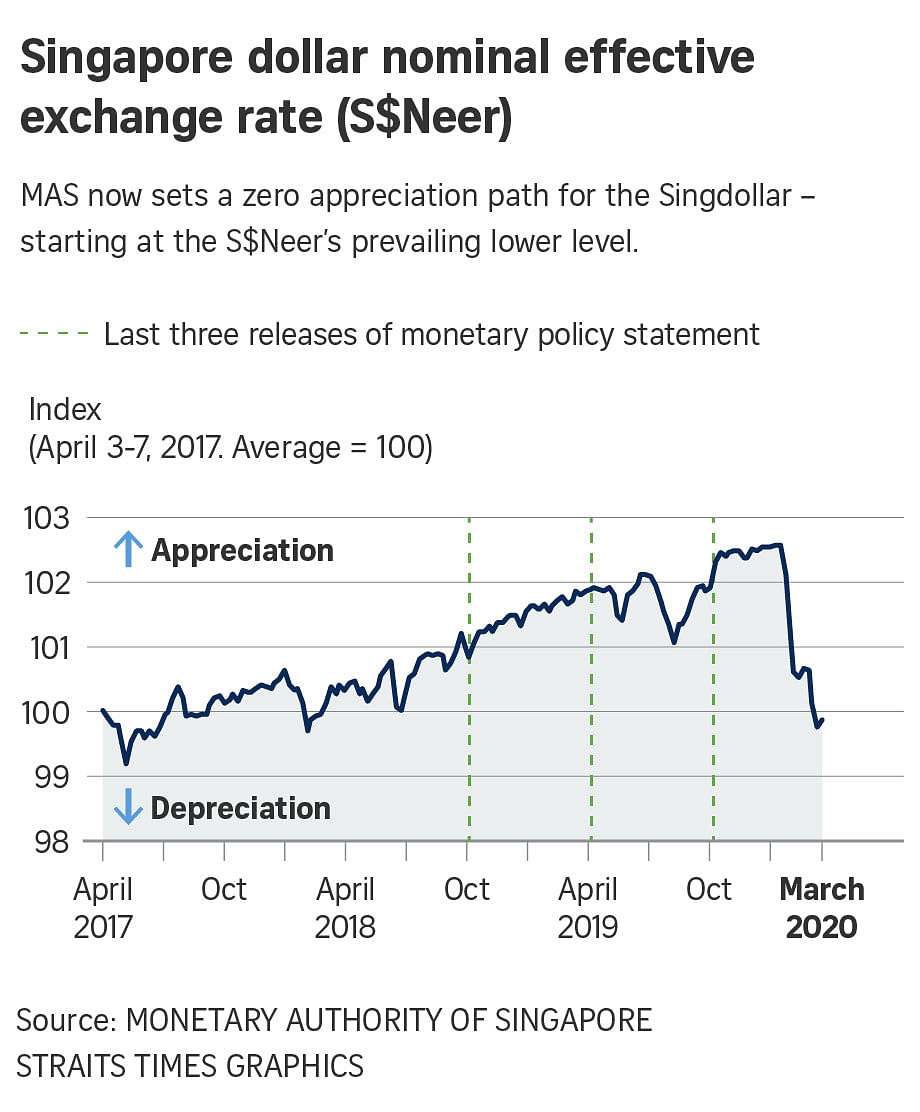MAS eases Singdollar policy in measured move as economy braces for recession
Sign up now: Get ST's newsletters delivered to your inbox

Singapore' economy is forecast to shrink by 1.0 to 4.0 per cent this year.
ST PHOTO: LIM YAOHUI
Follow topic:
SINGAPORE - The Monetary Authority of Singapore (MAS) eased its policy stance on Monday (March 30) by setting the Singapore dollar's rate of appreciation at zero per cent at the prevailing lower level of its exchange rate policy band as the economy braces for a deep recession.
The widely expected move from the MAS is also effectively a lowering of the mid-point of the policy band. The last time the Singapore central bank lowered the band's centre was during the global financial crisis in 2009.
It is also the first time the MAS has taken the two policy measures together - reduced the slope of the policy band to zero per cent appreciation and allowed for the downward adjustment of the band.
The move comes as Singapore and the global economy head for a recession this year due to the escalating coronavirus outbreak. Central banks around the world have embarked on a wave of monetary policy easing to calm volatile financial markets.
The MAS uses the Singapore dollar's nominal effective exchange rate (S$NEER) as its main policy tool rather than interest rates, because Singapore is a small and open economy with a heavy dependence on trade. The S$NEER is the the exchange rate of the Singapore dollar managed against a trade-weighted basket of currencies of the nation's major trading partners.
The MAS said in the statement; " The Singapore economy will enter a recession this year, with GDP growth projected at −4 to −1 per cent."
"With the deterioration in macroeconomic conditions and expectations of a weaker outlook, the S$NEER has depreciated to a level slightly below the mid-point of the policy band," it added.
The MAS said it will adopt a zero per cent per annum rate of appreciation of the policy band starting at the prevailing level of the S$NEER. There will be no change to the width of the policy band.
"This policy decision hence affirms the present level of the S$NEER, as well as the width and zero per cent appreciation slope of the policy band going forward, thus providing stability to the trade-weighted exchange rate," said the MAS.
CIMB Private Banking economist Song Seng Wun said noted that the existing market forces have already caused the Singdollar to drop below the midpoint of the S$NEER, even before MAS announced its move.
By flattening the slope and letting the currency crawl along the lower path, the MAS is hoping to keep prices stable, he said.
The MAS' mandate is to maintain price stability, so its job is to ensure that residents are not shocked by sudden increases or decreases in prices, he added.
The Singapore dollar has been volatile in the past several weeks, along with global financial markets. The currency hit a low of 1.4650 against the US dollar on March 23, before recovering to around 1.43 last Friday.
The Singdollar traded marginally lower at around 1.4274 against the greenback after the MAS policy announcement, with the local currency having already weakened in anticipation of the easing and as the US dollar stayed under pressure.
Associate Professor Lawrence Loh at the National University of Singapore Business School said that "the depreciation of the Singapore dollar will make imported goods more expensive but this can be mitigated by higher economic growth and higher consumer spending power".
"It is good that our inflation has been low in recent months so the impact on overall prices may not be too big," he added.
The MAS also lowered its 2020 forecast range for both core inflation and overall inflation to −1 to 0 per cent. Its previous 2020 forecasts for both indicators was 0.5 per cent to 1.5 per cent.
This comes after core inflation in February fell into negative territory for the first time in a decade as as the pandemic's damage to demand outweighs price pressures from supply disruptions.
The MAS said core inflation is likely to remain below its historical average in the near and medium term as "there is significant uncertainty over the depth and duration of this recession."
The Ministry of Trade and Industry (MTI) announced the sharp GDP growth downgrade last Thursday saying the economy will shrink amid mounting border controls and lockdowns around the world and a sharp pull back in domestic consumption.
The midpoint of the forecast range, 2.5 per cent, will make the contraction the worst since the Asian Financial Crisis in 1998 when annual GDP growth shrank 2.2 per cent. The lower end of the estimate, if it materialises, is only compared to a 3.2 per cent contraction in 1964.
The midpoint of the forecast range, 2.5 per cent, will make the contraction the worst since the Asian Financial Crisis in 1998 when annual GDP growth shrank 2.2 per cent. The lower end of the estimate, if it materialises, is only compared to a 3.2 per cent contraction in 1964.

This is the second downgrade for GDP growth in over a month. The last estimate was -0.5 per cent to 1.5 per cent, released just before Budget 2020 in February.
Given the rapid deterioration of the economic outlook, Singapore announced a Supplementary Budget of about $48 billion last week. That is in addition to the stimulus package of $6.4 billion in the Budget unveiled last month and puts the total at $55 billion, or 11 per cent of GDP.
The MAS said the two Budget aid packages will help to preserve jobs, while its money market operations will at the same time provide sufficient liquidity to the financial system. Monetary policy will complement these efforts and ensure price stability over the medium term, it added.
The central bank expects external sources of inflation to weaken in the near term amid the global downturn and, in particular, due to the sharp slide in benchmark oil prices which are expected to stay low for an extended period.
"However, supply chain disruptions arising from worldwide measures to contain COVID-19 could put some temporary upward pressure on imported food prices," it said.
On the domestic front, some labour market slack could emerge as firms pull back on their hiring plans, even as the scale of retrenchments is mitigated by the government's Jobs Support Scheme, the MAS said.
"The resident unemployment rate is expected to rise and wage growth ease. Meanwhile, non-labour costs such as retail rents should stay subdued," it said.
"Consequently, disinflationary pressures are expected to broaden, even as the prices of some imported items are likely to increase as a result of the disruptions in production and transport," the MAS said.

